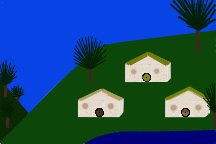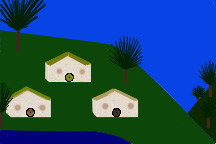 |
|
 |
 |
|
 |
Concerning Hobbits | Calendars & Chronologies | Shire Library | Shire Geography | Mathom House (Misc) | Home Page
Mardil later introduced a Revised Calendar that was called the Steward's Reckoning. It was followed by most Westron speakers except for the Hobbits. Every month consisted of 30 days. One day was introduced between the third and fourth months (March and April) and between the ninth and tenth months (September and October). The five days outside of months, yestar� (the first day of the year), tuil�r�, lo�nd� (Mid-Year's Day), y�vi�r�, and mettar� (the last day of the year) were holidays.
In Westron, the Quenya names of the months were retained although the Dunedain used the Sindarin equivalents. They were: Narviny� (January - Sindarin Narwain), N�nim� (February - Sindarin N�nui), S�lim� (March - Sindarin Gwaeron), V�ress� (April - Sindarin Gwirith), L�tess� (May - Sindarin Lothron, N�ri� (June - Sindarin N�rui), Cermi� (July - Sindarin Cerveth), Urim� (August - Sindarin Urui), Yavanni� (September - Sindarin Ivanneth), Narqueli� (October - Sindarin Narbeleth), H�sim� (November - Sindarin Hithui), and Ringar� (December - Sindarin Girithron).
The Hobbits of the Shire introduced one change, which was eventually adopted in Bree. Special days, such as Mid-year's Day and Overlithe, were not assigned a weekday name. They no longer belonged to any week. Weekday names thus never changed from year to year. The year always began on the first day of the week and ended on the last day of the week. The Shire-folk stopped putting weekday names on the dates in their letters, since they never changed. This worked as long as they never went farther than Bree.
The Shire names of the calendar months were: Afteryule (January), Solmath or Somath (February), Rethe (March), Astron (April), Thrimidge or Thrimich, originally Thrimilch (May), Forelithe (June), (Midyear's Day and sometimes Overlithe), Afterlithe (July), Wedmath (August), Halimath (September, Winterfilth (October), Blotmath, which was pronounced Blodmath or Blomath (November), and Foreyule (December). These names came from their days in the Vales of the Anduin and are similar to those of Rohan and Dale. The Lithe day before Mid-Year was called 1 Lithe and the one after Mid-Year was called 2 Lithe. The Yule at the end of the year was 1 Yule and the Yule day the beginning of the year was 2 Yule.
The Hobbits of Bree used the following names of the month: Frery (January), Solmath (February), Rethe (March), Chithing (April), Thrimidge (May), Lithe (June), The Summerdays, Mede (July), Wedmath (August), Harvestmath (September), Wintring (October), Blooting (November), and Yulemath (December). Frery, Chithing, and Yulemath were also used in the Eastfarthing. The Bree-folk laughed at the Winterfilth of the Shire. The Shire-folk in turn said that the Bree-folk's Wintring was an adaptation of the older name, which referred to the filling or completion of the year before winter. This name came from before the time the Hobbits adopted the King's Reckoning and reflected a time when the year started after the harvest.
The archaic Hobbit names for the days of the week were: Sterrendei (later Sterday), Sunnendei (Sunday), Monendei (Monday), Trewesdei (Trewsday), Hevenesdei (Hevensday or Hensday), Meresdei (Mersday), and Highdei (Highday). Friday was their Highday and the last day of the week. Highday from noon on was a holiday and was often celebrated by an evening feast.
The Fourth Age began with the September departure of Elrond and the Ringbearer. For ease in record-keeping, Fourth Age 1 was the year that started with March 25, 3021, old style. The Shire-Folk did not celebrate March 25 or September 22. The Hobbits of Westfarthing, especially those around Hobbiton, celebrated April 6 with a holiday and dancing at the Party Field. Some claimed that it was the birthday of Sam Gardner. Others said it was the day the Golden Tree first flowered in SR 1420. A third theory held that it was the Elves' New Year. The Shire's April 6 was more or less equivalent to yestar� (the first day of the year) in the Calendar of Imladris. In Buckland the Horn of the Mark was blown at sundownon November 2, followed by bonfires and feasts. This event recalled the first blowing of the Horn in the Shire in 3019.
From the Appendixes of the Lord of the Rings
Visit Calendars and Chronologies
Visit our smial (home)